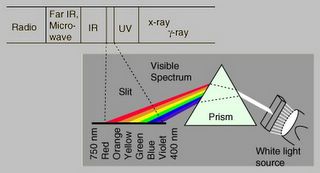What's in a leaf?
Someone mentioned beautiful fall foliage in a comment on last week's Thankful Thursday post. It got me thinking about the fascinating mechanism by which the change to fall foliage colours occurs. (Some trees are already donning their fall colour in this region.) So here begins the lesson in plant physiology.

Plant leaves contain a variety of pigments which allow them to utilise the full spectrum of visible light (part of the electromagnetic spectrum).
Together the range of pigments form an action spectrum over which photosynthesis occurs.

Action spectrum of photosynthesis of the green alga Chlorella pyrenoidosa (quantum yield of oxygen production as a function of wave length). Please notice the drastic drop in the red part of the spectrum (R. EMERSON and LEWIS, 1943). This is similar to the action spectrum of your average vascular plant.
The colours we see in plant leaves are the light reflected back by the plant pigments. The level of each pigment in a leaf determines its colour. In the fall changes in the environment affect those levels. The combination of cooler weather, longer nights, and a change in the quality of light reaching the leaf (more of certain wavelengths than others) triggers the reduction of the chlorophylls and production of other pigments. This is all in preparation for winter dormancy. These changes allow us to see the other pigments that had been masked by the chlorophylls during the growing season as well as the new pigments being produced.
Tannins also lend to fall colour but are not involved in capturing light for photosynthesis. They are waste products. Brew yourself up a really strong cup of tea and you'll be able to see and taste the tannin stored in the tea leaves. In some wooded areas the concentration of tannins put out by trees is so high that it turns nearby streams and rivers brown like tea.
Anthocyanins are the most interesting of the pigments to me. They are most affected by the fall change in temperature. These pigments also change colour with pH. Try this experiment in your kitchen. Get yourself some bleach, vinegar, and water (tap, filtered, or whatever). Now get out some grape juice (no white grape juice please). Mix a few drops of the juice with a few drops of bleach. Do the same with the vinegar and water. Use a separate white container (or a clear container on a white background) for each mix. Cool isn't it? These are the pigments responsible for the range of colours in hydrangeas and the red tips of emerging tulip shoots in the spring.

Reds and pinks are acidic (low pH). Blues and purples are basic (high pH).
(Apparently this is not really the case with hydrangeas but it is with other plants. See the comments section for clarification.) Problem solved the pH of the cell determines the colour of hydrangea flowers not the soil pH.
Visit these sites for more information. The articles get more technical as you go down the list.
Why Leaves Change Color
Leaf Coloration
Visible Light Waves
Fall Tree Color Pigments
The Electromagnetic Spectrum
Chemistry of Autumn Leaf Color (PDF)
Why Leaves Change Color - The Physiological Basis
Action & Absorption Spectra
Photosynthesis (Quantum Yield)
Action & Absorption Spectra
Plant Carotenoids: Pigments for Photoprotection, Visual Attraction, and Human Health (PDF)

Plant leaves contain a variety of pigments which allow them to utilise the full spectrum of visible light (part of the electromagnetic spectrum).

Together the range of pigments form an action spectrum over which photosynthesis occurs.

Action spectrum of photosynthesis of the green alga Chlorella pyrenoidosa (quantum yield of oxygen production as a function of wave length). Please notice the drastic drop in the red part of the spectrum (R. EMERSON and LEWIS, 1943). This is similar to the action spectrum of your average vascular plant.

The colours we see in plant leaves are the light reflected back by the plant pigments. The level of each pigment in a leaf determines its colour. In the fall changes in the environment affect those levels. The combination of cooler weather, longer nights, and a change in the quality of light reaching the leaf (more of certain wavelengths than others) triggers the reduction of the chlorophylls and production of other pigments. This is all in preparation for winter dormancy. These changes allow us to see the other pigments that had been masked by the chlorophylls during the growing season as well as the new pigments being produced.
- Chlorophylls absorb red and blue wavelengths
- a: bright green
b: olive green
pheophytin: brown - Carotenoids absorb blue wavelengths
- Xanthophylls: yellow, tan
Lycopene: red
beta-Carotene: orange - Anthocyanins: absorb green wavelengths red, pink, purple, blue
Tannins also lend to fall colour but are not involved in capturing light for photosynthesis. They are waste products. Brew yourself up a really strong cup of tea and you'll be able to see and taste the tannin stored in the tea leaves. In some wooded areas the concentration of tannins put out by trees is so high that it turns nearby streams and rivers brown like tea.
Anthocyanins are the most interesting of the pigments to me. They are most affected by the fall change in temperature. These pigments also change colour with pH. Try this experiment in your kitchen. Get yourself some bleach, vinegar, and water (tap, filtered, or whatever). Now get out some grape juice (no white grape juice please). Mix a few drops of the juice with a few drops of bleach. Do the same with the vinegar and water. Use a separate white container (or a clear container on a white background) for each mix. Cool isn't it? These are the pigments responsible for the range of colours in hydrangeas and the red tips of emerging tulip shoots in the spring.

Reds and pinks are acidic (low pH). Blues and purples are basic (high pH).

Visit these sites for more information. The articles get more technical as you go down the list.
Why Leaves Change Color
Leaf Coloration
Visible Light Waves
Fall Tree Color Pigments
The Electromagnetic Spectrum
Chemistry of Autumn Leaf Color (PDF)
Why Leaves Change Color - The Physiological Basis
Action & Absorption Spectra
Photosynthesis (Quantum Yield)
Action & Absorption Spectra
Plant Carotenoids: Pigments for Photoprotection, Visual Attraction, and Human Health (PDF)


Comments
Post a Comment